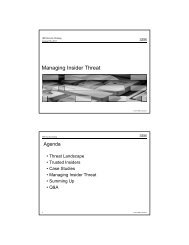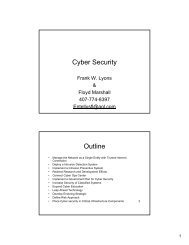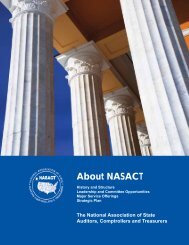Advisory Committee on Tax Exempt and Government Entities (ACT ...
Advisory Committee on Tax Exempt and Government Entities (ACT ...
Advisory Committee on Tax Exempt and Government Entities (ACT ...
You also want an ePaper? Increase the reach of your titles
YUMPU automatically turns print PDFs into web optimized ePapers that Google loves.
The Appropriate Role Of The Internal Revenue Service With Respect To <strong>Tax</strong>-<strong>Exempt</strong> Organizati<strong>on</strong> Good Governance IssuesAPPENDIX 3. HEALTH CARE The law of charity has always evolved to reflect the changing needs of society <strong>and</strong> thatflexibility has been critical in c<strong>on</strong>sidering under what circumstances hospitals <strong>and</strong> otherhealth care organizati<strong>on</strong>s qualify for exempti<strong>on</strong>. 185 The voluntary hospital of todayoperates very differently from Pennsylvania Hospital in 1751 or even the typicalcommunity hospital of the 1950s; 186 <strong>and</strong> other types of health care organizati<strong>on</strong>s thatcould not have been imagined five, ten, twenty or forty years ago have developed overthe years. Thus, the IRS has been required to distinguish a health care organizati<strong>on</strong>that qualifies for exempti<strong>on</strong> from <strong>on</strong>e that is merely the for-profit practice of medicine. Invarious situati<strong>on</strong>s, the IRS has imposed such governance requirements as a communityor independent board, m<strong>and</strong>ated specific board approval of transacti<strong>on</strong>s, <strong>and</strong> requiredadopti<strong>on</strong> of a c<strong>on</strong>flict of interest policy.In Revenue Ruling 56-185, 187 the IRS established for the first time a specific st<strong>and</strong>ardfor n<strong>on</strong>profit hospital exempti<strong>on</strong>, relying principally <strong>on</strong> the “relief of poverty” rati<strong>on</strong>ale.However, with the passage of the Medicare <strong>and</strong> Medicaid statutes in 1965, whichprovided for government reimbursement of a substantial porti<strong>on</strong> of the free carepreviously subsidized by tax-exempt hospitals, the IRS rethought the basis for hospitalexempti<strong>on</strong>. The challenge was to acknowledge that “promoti<strong>on</strong> of health” was a type ofcommunity benefit, like the “relief of poverty,” that could c<strong>on</strong>stitute the basis forexempti<strong>on</strong>, while at the same time distinguishing a hospital organized <strong>and</strong> operated forcharitable purposes from <strong>on</strong>e that primarily served private interests. In Revenue Ruling69-545, 188 the IRS provided an example of a hospital qualifying for exempti<strong>on</strong> <strong>and</strong> anexample of a hospital that did not qualify for exempti<strong>on</strong>. One of the factors the IRS citedas distinguishing the “good hospital” from the “bad hospital” was that the former wasgoverned by a board of trustees comprised of independent civic leaders. The emphasis<strong>on</strong> a community board can be viewed as an early foray into imposing a governance185See, e.g., Mary Jo Salins et al., Evoluti<strong>on</strong> of the Health Care Field, <strong>Exempt</strong> Org. C<strong>on</strong>tinuing Prof. Educ. Tech. Instructi<strong>on</strong>Program 1992 at 157, 158-59.186For an historical discussi<strong>on</strong> of the law of charities as applied to hospitals, see, generally, Robert S. Bromberg, <strong>Tax</strong> Planning forHospitals <strong>and</strong> Health Care Organizati<strong>on</strong>s (1977), Chapter 7; Douglas Mancino, Income <strong>Tax</strong> <strong>Exempt</strong>i<strong>on</strong> of the C<strong>on</strong>temporaryN<strong>on</strong>profit Hospital, 32 St. Louis U. L.J. 1015 (1988).187Rev. Rul. 56-185, 1956-1 C.B. 202. The IRS set forth a number of criteria for exempti<strong>on</strong>, including: the hospital must “beoperated to the extent of its financial ability for those not able to pay for the services rendered <strong>and</strong> not exclusively for those who areable to pay;” the hospital must not restrict the use of its facilities to a particular group of physicians <strong>and</strong> surge<strong>on</strong>s to the exclusi<strong>on</strong> ofall other qualified doctors; <strong>and</strong> the hospital may set aside earnings to be used for improvements <strong>and</strong> additi<strong>on</strong>s to hospital facilities.188Rev. Rul. 69-545, 1969-2 C.B. 117, c<strong>on</strong>trasted two hospitals, <strong>on</strong>e that qualified for exempti<strong>on</strong> <strong>and</strong> <strong>on</strong>e that did not. The keyfactors in the IRS’s favorable ruling were: the hospital operated a full-time emergency room that treated all pers<strong>on</strong>s requiringemergency care regardless of ability to pay; the hospital provided care to all pers<strong>on</strong>s in the community who could pay for services,either by themselves or through private health insurance or public programs such as Medicare <strong>and</strong> Medicaid; medical staff privilegeswere available to all qualified physicians in the area, c<strong>on</strong>sistent with the hospital’s size <strong>and</strong> the nature of its facilities; the hospitalwas governed by a board of trustees comprised of independent civic leaders; transacti<strong>on</strong>s between the hospital <strong>and</strong> members of themedical staff were at arm’s length; <strong>and</strong> the hospital used its surplus of receipts over disbursements to improve the quality of patientcare, exp<strong>and</strong> facilities <strong>and</strong> advance its medical training, educati<strong>on</strong> <strong>and</strong> research programs. The emergency room requirementstemmed from the fact that indigent pers<strong>on</strong>s who were not covered by Medicare or Medicaid (or cared for in public hospitals) tendedto receive their care in hospital emergency rooms or <strong>on</strong> admissi<strong>on</strong> to the hospital through the emergency room. Many hospitals <strong>on</strong>lyprovided emergency care for indigents <strong>and</strong> then transferred poor uninsured patients to public hospitals or other hospitals that servedcharity cases. Subsequently, in Revenue Ruling 83-157, C.B., 1983-2 94, the IRS acknowledged that the operati<strong>on</strong> of anemergency room is not an absolute requirement for exempti<strong>on</strong>. While Medicaid is not explicitly referenced in the revenue ruling, theIRS applies this requirement equally to Medicaid. See, e.g., Salins, supra, note 186, at 159.ADVISORY COMMITTEE ON TAX EXEMPT AND GOVERNMENT ENTITIES (<strong>ACT</strong>) June 11, 2008 85













